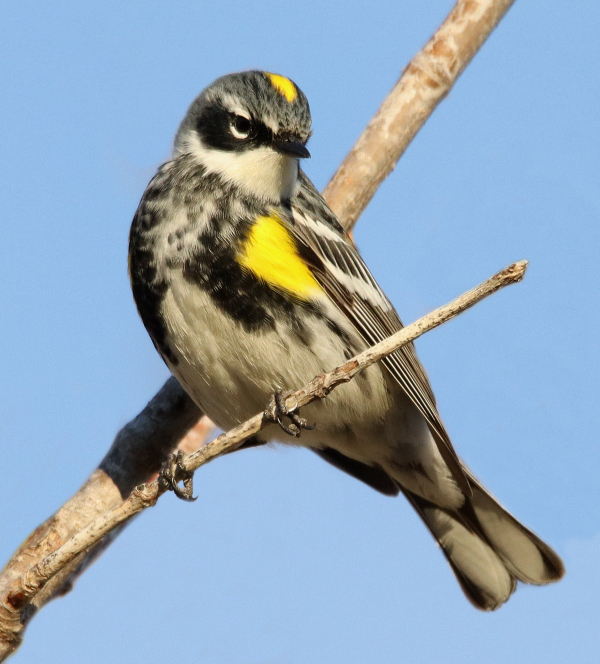
Yellow-rumped Warblers provided a number of thrilling photo sessions after the first warblers of spring arrived in my yard and in area tree groves.
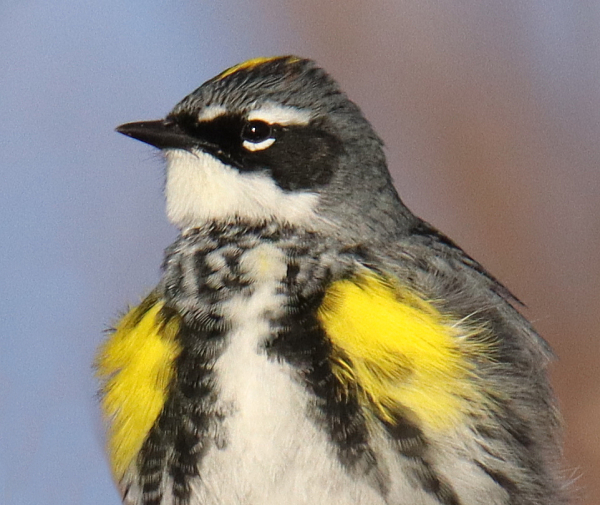
Keeping in mind that Yellow-rumped Warblers are remarkably small, this close portrait is something of a breakthrough photo as it ruffled its feathers a bit.
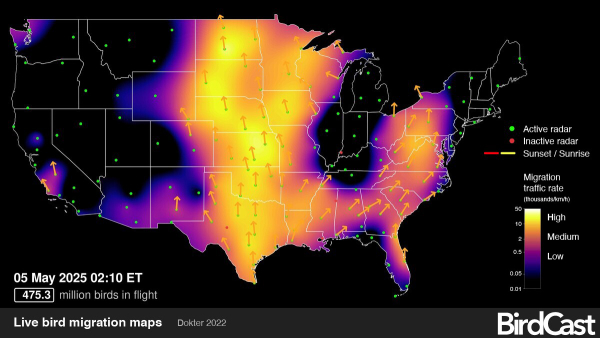
The week has been dominated by sunny days with big migrations north above the Great Plains overnight, as illustrated by this view of the BirdCast Live Bird Migration Map at 2am early Monday morning (BirdCast image provided online by the Cornell Lab of Ornithology).
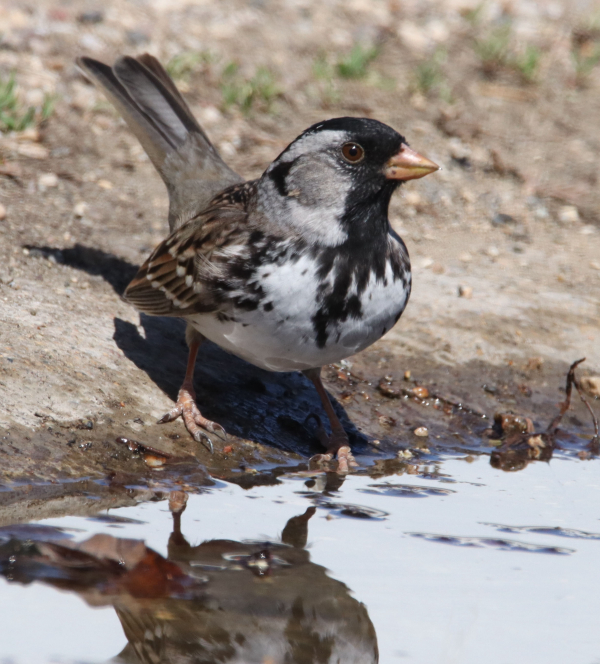
Always a welcome sight, a dramatically colored Harris’s Sparrow looks like a different bird compared to the fall and winter plumage of the species; very different from the single Harris’s Sparrow that spent the winter in my yard and neighborhood.
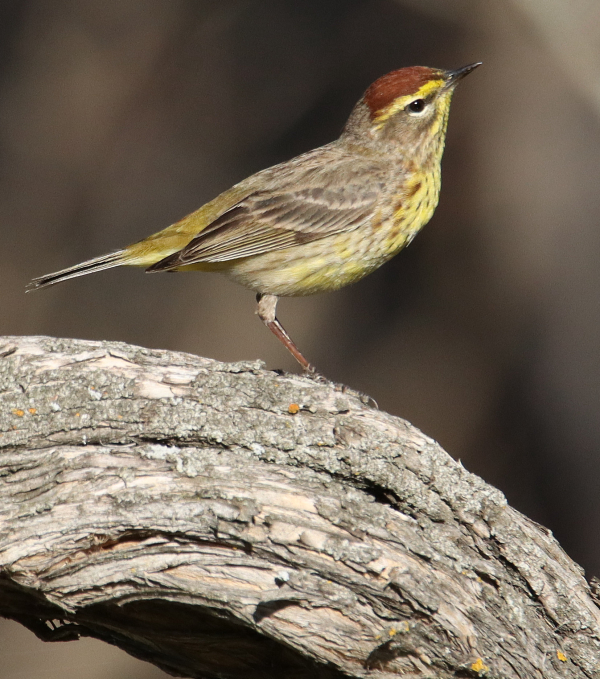
A Monday evening surprise, the first Palm Warbler provided a photograph as it foraged about 4 feet above the ground.
|
May is such an exciting month in the northern plains and woodlands, and to emphasize that point the past week was punctuated by the arrival of the first warblers Wednesday morning, Yellow-rumped Warblers and Orange-crowned Warblers, along with Brown Thrashers, with daily newbies including a Black-and-White Warbler followed, a Ruby-crowned Kinglet, House Wrens, Purple Martins, Barn Swallows, a Red-necked Grebe, American Bitterns, a Black-crowned Night Heron, Say’s Phoebes, Western Kingbirds, Upland Sandpipers, Pectoral Sandpipers, White-rumped Sandpipers, and Least Sandpipers.
Sunday was native sparrow day, with the first Harris’s Sparrows, White-throated Sparrows, and a White-crowned Sparrow arriving to join Chipping Sparrows and Clay-colored Sparrows that appeared earlier in the week. Monday’s new birds were Palm Warblers, a Lark Sparrow, and Lincoln’s Sparrows. Tuesday morning the first Yellow Warblers and Least Flycatchers arrived! I would also add that there was a standout Loggerhead Shrike, the second of spring, and 3 male American Goldfinches in full color that perched for a moment while I was photographing warblers, then headed northbound. And a surprise late Pine Siskin also checked out my feeding station Monday.
As the sun appeared Thursday morning, I was excited to try to photograph some of the warblers that first arrived the day before. I didn’t venture very far from my office, just a couple hundred yards to Melody’s Grove where there were many warblers – almost all Yellow-rumped Warblers, but a few Orange-crowned Warblers and a Black-and-white Warbler. Photographing warblers at Melody’s Grove has become an annual thrill during May, and because it’s close to home it’s always my first stop to check on migrating songbirds, flycatchers, and other birds each morning. Thursday a surprise visitor was a male American Kestrel – a first time observation at the Grove, and when I circled back an hour later it was at the same locale, which made me hope it found a suitable cavity in one of the giant cottonwood trees.
Later in the day, when the sun broke through afternoon clouds again, I checked 2 other wooded hotspots. As it turned out, the Country Schoolhouse Grove provided the best photo opportunities, and held the most warblers by far Thursday through Saturday. The enjoyable photo sessions during that period are described in the Bird Photography feature is week’s issue. Although there were excellent night migrations across the northern Great Plains Friday night thru Tuesday morning the south wind made new birds harder to find, but Sunday a small group of Yellow-rumped Warblers foraged low in my yard at a mid-afternoon point.
Knowing the wind was a factor, I abbreviated my Sunday evening birding drive and while all but 1 warbler had evacuated the Schoolhouse Grove, there were new native sparrows on hand. First to show was a single White-crowned Sparrow among a large flock of almost 20 Chipping Sparrows. A few Clay-colored Sparrows were foraging too, and when I checked out a chunky songbird perched 10 feet above ground, then another, I was happy to see my favorite native sparrows – Harris’s Sparrows. Looking in the opposite direction, the lone Yellow-rump caught my attention, as did 2 White-throated Sparrows – bingo.
That said, as I was writing the above paragraph Monday, a small songbird flew across my bay window view and appeared to land on the ground, out of sight. Interested, I stepped into the bay and saw 2 small sparrows that didn’t show any standout identifying features in the shade, and they scurried into taller grass before I could get a good look. As I waited with binoculars, I thought maybe they were Lincoln’s Sparrows, and when one sparrow stepped into the open, it was a Lincoln’s indeed – the first of spring. The wind kept me from my usual morning check, but a moment later as I began writing this sentence, a beautiful Yellow-rumped Warbler landed low in the elm tree outside the bay windows, then another, 2 more, and yet another joined it, a little wave of warblers that transferred to newly leaved chokecherry trees that line my backyard. They were relaxed and began foraging – wonderful – but it was a less than subtle hint that I should check on Melody’s Grove.
Before I left, I referenced the BirdCast live migration radar map for the preceding 24 hours, and it showed an amazing migration that continued throughout Sunday, hit a crescendo overnight, and was ongoing during daylight hours in a continuing migration of birds. When I arrived for a mid-afternoon look at Melody’s Grove, it was in motion with actively foraging Yellow-rumped Warblers, and midway between the Grove and home a rainwater puddle was attracting a parade of migrants, including Yellow-rumps and a variety of native sparrows – Harris’s, White-throated, Clay-colored, Chipping, and the first Lark Sparrow of spring.
That evening I checked the Country Schoolhouse Grove and it was full of Chipping Sparrows with scattered warblers, with almost equal numbers of newly arrived Yellow-rumped, Orange-crowned, and Palm Warblers. The previous evening only 1 warbler was present, so the birds Monday evening could be considered new arrivals, with the Palm Warblers the first of spring. I checked Melody’s Grove again as I was returning to my office and found it was bustling with Yellow-rump activity, but I also observed 3 Palm Warblers there, bringing my overall warbler species count to 4, with many more on the way.
After another big night of songbird migration, Tuesday morning dawned very different at Melody’s Grove. There were far fewer Yellow-rumped Warblers, but overall warbler numbers were about the same with new Orange-crowned Warblers filling in, along with the first Yellow Warblers and Least Flycatchers of spring, another Black-and-white Warbler, a Ruby-crowned Kinglet, and more Palm Warblers. It is so fun to see a flurry of warblers filling the Grove, and I was taken by just how bright male Yellow Warblers are after you haven’t seen such beaming color in many months. On my way back, it seemed all the trees between my office and Melody’s Grove had warblers in them or flying between them. I can’t wait to get back to the Groves after sending off this issue of The Birding Wire later today.
Each spring when I begin spending extended time in the little groves of trees that attract migrating songbirds, I find that spending time in the quiet recesses surrounded by tall and small trees, hearing and feeling the fresh breeze, noticing every sound and every movement; it really gets me in tune with nature, which extends to everywhere I roam in search of birds to photograph. You can see daily changes in the grasses, leaves, and flowering trees and bushes – and in the variety and numbers of birds on hand. In the quiet, the sound of a robin singing while a dove coos sounds so remarkable after the quiet of winter, and the colors of green are transforming the land. It reminds me that birding is about more than the birds, but it’s the birds that make me appreciate it all the more. Enjoy this exciting week of bird migration!
Article and Photos by Paul Konrad
Share your bird sightings and photographs at editorstbw2@gmail.com